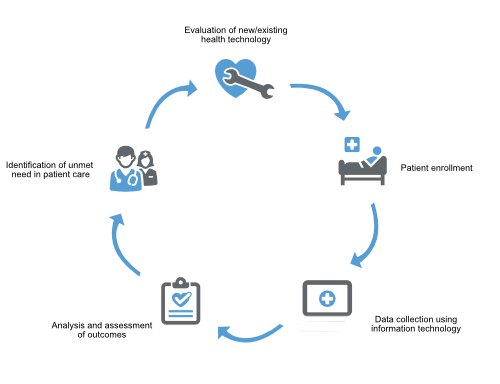Patient care has benefited substantially from technological advances over the last decades. Each year, more and more previously complicated conditions and diseases are becoming treatable. More available treatments, however, do not increase a payer’s budgets, but rather place an increased burden on already scarce resources. This is where value-based healthcare has grown to be an essential part of the decision-making process for both industry and payers. Health-economic assessment informs decisions on how to utilize available resources (e.g., time and money) to achieve the greatest benefit for a target population, taking both budget impact and quality of life into account. Such an assessment requires data on health benefits and efficient, easy methods for their collection.
In 2017, the European parliament adopted stricter regulations on product safety for medical devices, which will be enforced from 2020 [1]. This means data on product safety must be regularly generated and be specific to the manufacturer’s device. Together, value-based healthcare and increasingly rigid regulatory demands are requiring manufacturers to show both safety and the evidence-based marginal benefit for each product: we need more data.
Value-based healthcare provides a means to initiate hospital change at low economic risk to the payer, while collecting real-world safety and use data. The advantage of this technique is that the data can be collected locally during daily practice. Given a smart choice on approach and technology, the burden can be reduced to an extent that the data collection can be naturally included in the hospital workflow. The benefit of this method is on both sides: the hospital can evaluate care quality while the manufacturer receives valuable insights into their product’s performance. The data collected give feedback over procedure counts attributed to the exact medical device for a single site, allowing for robust estimates of device usage. With ongoing data collection programs, data on annual incidence rates and safety events can also be derived, aiding in report building for the respective health technology.

Figure: Utilizing mobile tablet computers to perform in-hospital data collection is an elegant way to reduce staff workload and conform to data-protection laws and allow full control of the collected data.
Two factors need to be established before implementing a data-collection project. First, it is important to identify the unmet needs the product is addressing. This includes the identification of market-entry points and/or to further sharpen the product’s unique selling points against the competition. Second, one must identify how the medical device under evaluation is to be integrated into the existing hospital care pathway and where the data collection needs to occur. Data collection must comply with the relevant data-protection laws, have reduced visibility, and for it to succeed, the workload impact for hospital staff must be minimal.
Elegant measures are customized apps developed for mobile tablet computers that can be easily carried around or be stowed away with a minimum requirement for space. These tablet computers are capable of complex operations, are available with wireless technology and have the battery capacity to endure a full work day. Using wireless technology, the data can be transferred securely to GDPR-compliant servers, allowing for real-time reporting and manual in-depth analysis. This allows for intermediate control of the data collection, to identify possible bottlenecks and training requirements before completion. Other advantages of this method are that it reduces administrative requirements due to paper filing, data collection and archiving, and the tablets can be tracked via GPS and remotely wiped in case of a theft or loss of the device.
In closing a data-collection project, the performance of the medical device is summarized and a robust and evidence-based case for the product can be built upon the collected data. These data can be published together with other participating hospitals to enable an encompassing, cross-country evidence base. Both marginal benefits and regulatory requirements are addressed with this type of data collection.
References

